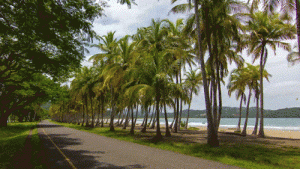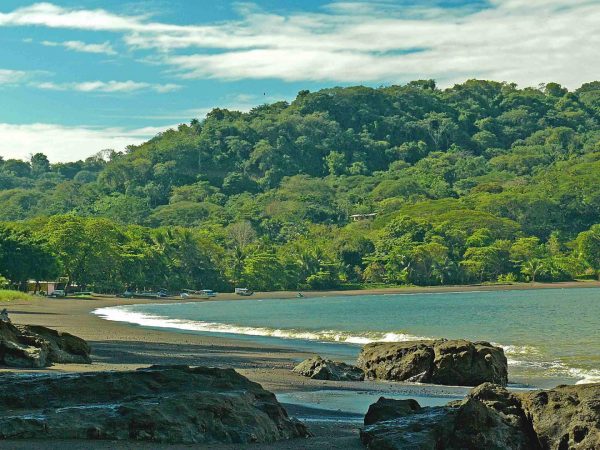Riches in Costa Rica
As one of the most economically and politically stable countries in Latin America, Costa Rica is viewed as a safe bet. We examine why now is the best time to get a slice of the action.
From its political to natural landscape, there are many reasons why Costa Rica is viewed by investors as one of the safest emerging markets to expand their real estate portfolio.
Its exports remain strong, tourism numbers are at record levels while the country has one of the highest levels of foreign direct investment per capita in Latin America. Historically, Costa Rica has been a profitable real estate investment with 15-20 per cent returns recorded year-on-year from 2000 to 2008. The financial crisis did have an impact on the market, but prices have stabilized in recent years.
Foreign investors have been capitalizing on this particular market of late with purchasing activity already up 14 per cent in the first quarter of 2013 compared to the same period last year.
Economically, Costa Rica’s GDP is expected to rise, which will fuel investor interest. The IMF indicates that the GDP will increase by 4.2 per cent in 2013 and 4.4 per cent in 2014.

Why invest?
In the aftermath of the global crisis, overinflated real estate prices dipped to more realistic and fair market values, according to local real estate agents.
“There is definitely a lot more interest in Costa Rica as investors see the long-term potential there, especially with the new airport terminal providing more access and new residential development projects,” says David Otanez from Recap Investments. “Prices have levelled off, so now is a great time to consider buying.”
Gross rental yields in Costa Rica remains generally healthy with average figures between 6 and 7.8 per cent. “The rental market is quite strong, as Canadian and U.S. snowbirds and tourists continue to flock to the country,” he says. “Investors can get from between $125 to $150 per night on a short-term rental basis. The returns in the long run are just as attractive.”
Hot spots
Costa Rica’s hot spots are the northern Pacific Coast and the southern zone. The former can be accessed by the Daniel Oduber International Airport in Liberia near the popular Guanacaste Gold Coast.
The southern zone is considered as the best place to invest due to advances in infrastructure, including a planned new airport and highway. A number of government-approved projects are expected to drive up property values and boost the region.
Much of the commercial activity is taking place in the Central Valley and San José’s greater metropolitan area.
Buying in Costa Rica
It is relatively easy to buy property in Costa Rica with a simple tourist visa. Many foreign investors set up a private business or corporation, as there is a lot of commercial freedom and protection with this method. It is even possible to establish a corporation in Costa Rica without having to obtain legal residency or citizenship. The taxes paid are based on gross income but applied to net income through this method.
Locals and foreigners enjoy the same rights in terms property ownership in Costa Rica. All potential buyers should hire a lawyer to carry out an independent title search and investigation to ensure the title details are true and accurate. When buying Costa Rican property, the title is transferred from seller to buyer by executing a transfer deed (escritura) before a public notary.
Otanez warns investors to be cautious and practical when assessing potential properties in Costa Rica. “As with all countries, there are a few good and bad projects, so due diligence is essential, especially when you are looking at the title of the land lot,” he says. “Look at regions that enjoy positive tourism figures, are near major access routes and (ensure) that the developer is legitimate.”
Once a sale has been agreed, a 10 per cent deposit is generally required and it is recommended that the monies be placed in a government-registered escrow account. Final closing can take between 30 and 60 days and it is also recommended to get title insurance to safeguard buyer interests.
Prices
Prices in Costa Rica vary from coast to coast. “You can pay anything from $65,000 to $250,000 CAD, depending whether it’s a land lot, house or new development,” says Otanez. The least expensive properties are more prominent in “up and coming areas,” such as the new developments in the South. Otanez says there has been a significant increase in residential development in recent years with many investors gravitating towards gated communities.
“With the U.S. local economies improving again, prices in Costa Rica are also rising as Americans are increasingly attracted to the region,” says Otanez. “I have seen that in some areas, but there is still a lot of value and return for investment.”
There have been an increasing number of Canadian real estate investment companies buying land in Costa Rica to construct eco-developments. Otanez says this type of investment is more suited to those who are more interested in buy-and-holds than flipping.
“The best returns are in the long run, especially as the country is set to continue enjoying increasing tourist and snowbird numbers.” With more foreigners moving into Costa Rica, demand for high end property has risen in key areas, such as San José.
Tenancy laws
Costa Rica’s tenancy laws are still very much pro-tenant. Rents can initially be freely negotiated between landlord and tenant and the minimum lease term is three years but the tenant can cancel it by serving a three month notice period.
If the rent has been agreed in any foreign currency, no yearly increases are allowed. Increases are only permitted if transactions are agreed and paid in the Costa Rican currency (the colones), while unpaid rent can be very difficult to collect.
Heating up in Honduras
To find the best real estate investment opportunities in Honduras, one must look beyond the tropical climate and attractions. Investor Randy Jorgensen did that, and is now profiting from the experience.
Successful real estate portfolios are not built overnight. It took Randy Jorgensen 16 years before he found the answers he had been looking for. A frequent visitor to Honduras, particularly the city of Trujillo, he realized there was money to be made there.
“After 16 years of vacationing and visiting, becoming familiar with the local regulations, and developing relationships, the opportunity presented itself, as Honduras began to encourage foreign investment with a focus on tourism,” the CEO of Life Vision Properties recounts.
“I felt if Honduras met all the criteria and Trujillo specifically met the ambience and location expectations I had; it would for others as well.”
In addition to being a great area for investing, the country’s economy is relatively strong. According to the IMF, the GDP is forecast to expand by 3.3 per cent in 2013 and 3 per cent the following year.
The first purchase
Originally from Moosomin, Sask., Jorgensen took the first step and built a vacation home in 1992. “My initial purchase was 42 acres with 1,000 feet of beachfront,” he says. “The property was covered with extremely thick jungle that could only be walked across by blazing a trail with a machete.”
Jorgensen knew that he faced an uphill battle with the undeveloped land. “The property was raw land with no services or infrastructure with a large swampy, low area,” he says. “The purchase price was $50,000 USD, and the original documentation stated 50 acres.”
He also faced issues with the actual size of the land. “It is common in Honduras for land size to be significantly different from documents to actual survey,” he continues. “The final size should only be accepted if a recent survey by a qualified surveyor and reviewed by a qualified civil engineer.”
Once the land survey process was complete, Jorgensen performed an extensive cleanup of the area. “After purchasing the land, plans were made to clear the property so topography could be conducted and further plans for road access, power, water, drainage where required, and choosing a site for the home,” says Jorgensen.
Jorgensen generally prefers to focus on areas that have had some development, as it makes the process easier for both investors and developers. “Clearing and infrastructure costs initially cost about $60,000,” Jorgensen says. “The low cost was mainly due to the ability to perform most of the work myself without paying outside contractors, and the luxury of taking four years to complete.”
Hot spot: Trujillo
Since entering the market 21 years ago, Jorgensen has always focused his attention on Trujillo. “I personally have begun developing property producing serviced acreages to enable ease of acquisition for foreign property owners, specifically Canadians,” Jorgensen says. “Currently, 1,500 acres are under development with 500 lots sold to date.”
Two key factors are responsible for Trujillo’s growth. The first is affordable average prices. Many properties in Trujillo can be purchased for between $200,000 and $250,000, according to the Global Property Guide.
The second reason is an expected influx of retirees and vacationers over the next 15 years. “The time to purchase at an affordable cost grows shorter each year, so anyone considering a tropical property should take action sooner than later to enjoy the lower pricing still available.”
Developing a strategy
As Jorgensen began to add to his portfolio, he developed an investment strategy that would best fit his personal needs. “When purchasing property as an investment, I first decide if it’s a short-term (3 to 5 years), or long-term (10 to 20 years) project,” he says.
He prefers the long-term approach when it comes to his holdings. He says he finds this method more financially stable and less susceptible to changes that may occur in the market.
Before entering a foreign market, Jorgensen advises investors to perform a detailed analysis of the area they’ll be targeting. “In both short– and long-term investments, use of the property needs to be clear, exit strategy developed, target market identified, and improvements to add value begin immediately,” he says. “Carrying costs need to be included in the projections and personal use needs a value assigned.”
Obtaining finance
One of the biggest obstacles Canadian investors face with international properties is obtaining financing. Jorgensen experienced a litany of financial issues when he began investing in Honduras, but he was able to find some solutions over time.
“Leveraging equity in current assets, (and) then using the funds to purchase the investment property is the most common (solution), followed closely by paying cash from (your) savings,” he reveals. “Vendor financing is sometimes available, particularly on serviced lots and raw land, but improvements, such as home building, will need financing as above, or be paid by cash.
“I usually only leverage the property when a clear income is being, or can be, realized that will carry the debt,” Jorgensen says. “I usually only consider this (for) commercial properties or long term residential rental properties, and only if I need the cash for a specific purpose; otherwise, I just enjoy the cash flow and income they produce.”
Although his portfolio has been profitable, Jorgensen believes his holdings have the potential to boost the Honduran economy. “(They) will provide a much-needed industry that will support local residents, create reasonably-paying jobs for young people, create government revenue to improve public services, improve and expand recreational activities for vacationers and visitors and expand product and service selection to improve living conditions for local residents,” he says.
